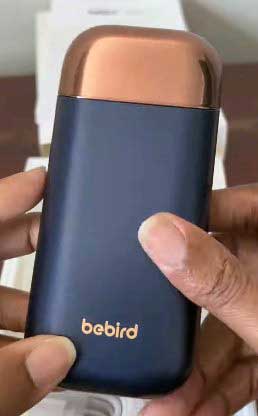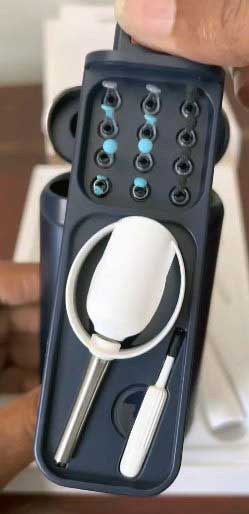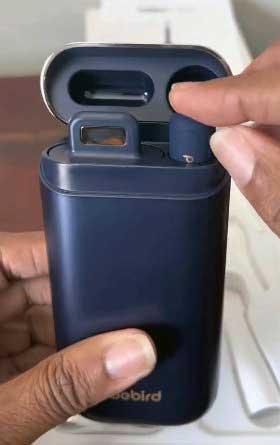
If you’re tired of dealing with earwax buildup and want a safe, effective solution, the Bebird ear wax removal tool is worth your attention.
I’ve tried countless methods to keep my ears clean, but this device’s high-definition camera and user-friendly design make it stand out.
It’s like having a professional ear cleaning kit at home, saving you time and doctor visits.
In this article, I’ll share my experience, break down the pros and cons, offer maintenance tips, and compare Bebird to other brands to help you decide if it’s right for you.
My Experience With Bebird Ear Wax Removal Tool
Let me take you back to the moment I first unboxed my Bebird EarSight Plus. The sleek packaging and compact device immediately gave me confidence—this wasn’t some flimsy gadget. Setting it up was a breeze. I downloaded the Bebird app on my iPhone, connected the device via Wi-Fi, and within minutes, I was peering into my ear canal on my phone screen. The 10-megapixel HD camera offered a crystal-clear view, and I couldn’t believe how detailed everything looked. It was both fascinating and a little gross to see the wax buildup I’d been ignoring.
Using the Bebird was intuitive, even for someone like me who’s not particularly tech-savvy. The soft silicone tips felt gentle, and the real-time visuals meant I could guide the tool with precision. I started with the ear scoop, gently twisting it to remove a stubborn chunk of wax. The LED light illuminated everything, so I never felt like I was guessing. It took about 10 minutes to clean both ears, and the difference was immediate—my hearing felt sharper, and that annoying clogged sensation was gone.
What surprised me most was how oddly satisfying the process was. Watching the wax come out in real time was like a mini-adventure. I even got my kids curious, and they loved exploring their ears (with supervision, of course). The device’s portability was a bonus—I tossed it into my travel bag for a recent trip, and the 90-minute battery life meant I didn’t need to recharge mid-use. My only hiccup was a slight Wi-Fi connection glitch the first time, but restarting the app fixed it. Overall, using Bebird felt empowering, like I was taking control of my ear health without needing a doctor’s appointment.
Read more: My Thoughts on VEVOR Vinyl Cutter
Pros Of Bebird Ear Wax Removal Tool
The Bebird ear wax removal tool has a lot going for it, and I’m excited to share what makes it shine. Here’s why I think it’s a standout choice for ear care:

- High-Definition Camera: The 10-megapixel camera delivers stunningly clear visuals, letting you see every detail of your ear canal. This precision makes cleaning safer and more effective than blind methods like cotton swabs.
- User-Friendly App: The Bebird app is intuitive and connects seamlessly to your smartphone via Wi-Fi. You can record videos or snap photos, which is great for tracking ear health or sharing with a doctor.
- Versatile Tips: Bebird comes with multiple silicone tips—scoops, tweezers, and droppers—designed for different wax types and ear sizes. This versatility means it works for adults, kids, and even seniors with harder wax.
- Portable Design: Its compact size and charging base make it perfect for travel. I’ve taken it on trips without worrying about finding an outlet, thanks to the long-lasting battery.
- Safe And Gentle: The soft silicone tips and safety stoppers prevent over-insertion, reducing the risk of injury. I felt confident using it on myself and my kids without fear of scratching the ear canal.
- IoT Connectivity: Bebird’s IoT feature allows real-time remote consultation with healthcare providers. This is a game-changer for those who want professional input without leaving home.
These features make Bebird a reliable, high-tech solution for ear care. The combination of visual guidance, ease of use, and safety features sets it apart from traditional methods. Whether you’re dealing with occasional buildup or chronic wax issues, Bebird’s thoughtful design makes the process straightforward and even a bit fun. It’s not just about cleaning your ears—it’s about doing it with confidence and control.
Cons Of Bebird Ear Wax Removal Tool
No product is perfect, and Bebird has a few quirks you should know about. Here’s what I found less than ideal during my use:
- Initial Setup Challenges: Connecting the device to Wi-Fi can be tricky for some. I had a brief hiccup with the app not syncing right away, which was frustrating until I restarted it.
- Price Point: Bebird’s advanced technology comes with a higher cost compared to basic ear cleaning tools like drops or manual picks. If you’re on a tight budget, this might feel like a splurge.
- Requires Steady Hands: While the camera helps, you still need a steady grip to maneuver the tool effectively. I fumbled a bit at first, which could be an issue for those with shaky hands.
- Not A Diagnostic Tool: The camera shows wax and debris clearly, but it’s not reliable for spotting serious ear issues like perforations. I wouldn’t use it to self-diagnose complex conditions.
- Tip Durability Concerns: Some users report that the silicone tips wear out with frequent use. I haven’t had this issue yet, but it’s something to watch for with long-term use.
These drawbacks don’t overshadow Bebird’s strengths, but they’re worth considering. The setup issue was minor for me, and the price feels justified given the features. If you’re comfortable with a bit of practice and don’t expect it to replace a doctor’s expertise, these cons are manageable.
Maintenance Tips For Bebird Ear Wax Removal Tool
Keeping your Bebird in top shape is crucial for consistent performance and hygiene. Here’s how I maintain mine to ensure it stays effective:

- Clean Tips After Each Use: After every session, I wipe the silicone tips with a clean cotton swab dipped in rubbing alcohol. This prevents wax buildup and keeps the tips hygienic for the next use.
- Store In Charging Base: I always store the device in its charging base to protect it from dust and damage. The base keeps all accessories organized and ensures the battery is ready when I need it.
- Replace Tips Regularly: Bebird recommends replacing silicone tips every few months, especially with frequent use. I check mine for wear and tear and swap them out to maintain safety and effectiveness.
- Keep The Camera Lens Clear: The anti-fog, anti-dust lens is great, but I gently wipe it with a soft, dry cloth to ensure clear visuals. Avoid harsh chemicals that could damage the lens coating.
- Charge Properly: I charge the device fully before storing it for long periods to preserve battery life. Overcharging isn’t an issue, but I avoid letting it drain completely to maintain battery health.
- Update The App: The Bebird app occasionally gets updates for better performance. I check for updates monthly to ensure smooth connectivity and access to new features like ear health tracking.
These steps keep my Bebird functioning like new. Regular cleaning and proper storage are key to avoiding issues like clogged tips or foggy visuals. By spending a few minutes on maintenance after each use, you’ll extend the device’s lifespan and ensure safe, effective ear cleaning every time.
Comparison With Other Brands
To give you a clear picture of how Bebird stacks up, I’ve compared it to other popular ear wax removal brands. Each has its strengths, but Bebird’s tech-forward approach makes it unique. Here’s how it fares against competitors.
Debrox Earwax Removal Drops
Debrox is a go-to for many because of its simplicity and affordability. It uses carbamide peroxide drops to soften wax, which you then flush out with a bulb syringe. I tried Debrox before Bebird, and while it worked for mild buildup, it was messy and required multiple sessions over days. Unlike Bebird’s real-time visual guidance, Debrox relies on guesswork, which can push wax deeper if you’re not careful. It’s great for budget-conscious users who don’t mind a slower process, but it lacks the precision and immediacy of Bebird’s camera-based system.
Q-Grips Earwax Removal Tool
Q-Grips uses a spiral silicone tip that you twist into your ear to remove wax. I found it gentle and easy to use for outer ear cleaning, but it’s not effective for deeper buildup. Without a camera, you’re working blindly, which risks irritation or incomplete cleaning. Bebird’s HD visuals and multiple tip options give it a clear edge for tackling various wax types safely. Q-Grips is cheaper and reusable, but it doesn’t offer the same level of control or versatility as Bebird.
Waterpik Earwax Removal Kit
Waterpik’s irrigation system uses warm water to flush out wax, which I found effective for soft buildup but risky for those with sensitive ears or perforated eardrums. The process is straightforward but can be messy, and there’s no way to see what’s happening inside your ear. Bebird’s dry, camera-guided method feels safer and more precise, especially for stubborn wax. Waterpik is a solid choice for non-invasive cleaning, but Bebird’s technology makes it more user-friendly and adaptable for all ages.
Linner Pictor Visual Ear Cleaner
Linner Pictor is Bebird’s closest competitor, offering a 300W HD camera and Wi-Fi connectivity for real-time visuals. I tested it briefly and liked its three-axis gyroscope for precise angles, but its app felt less polished than Bebird’s. Linner’s silicone tips are comfortable, but Bebird’s IoT connectivity for remote consultations gives it an advantage for those seeking professional input. Both are high-tech, but Bebird’s sleeker design and longer battery life made it my preference for regular use.
Bebird stands out for its combination of advanced technology, safety features, and versatility. While Debrox and Q-Grips are budget-friendly and Waterpik is gentle, they lack the precision of Bebird’s camera. Linner comes close but falls short in app refinement and unique features like IoT integration.
Also read: My Thoughts on Andersen Ranch Hitch Adapter
Frequently Asked Questions (FAQ)
Yes, the Bebird system works effectively for most users when used correctly. The HD camera and versatile tips make it easy to remove wax safely, as I experienced firsthand. It’s particularly great for stubborn or deep buildup, but you need to follow the app’s instructions to avoid mistakes. For severe cases, consult a doctor first.
The most effective method depends on your needs, but Bebird’s camera-guided system is among the best for at-home use. It offers precision that drops or irrigation can’t match. For complex cases, professional microsuction by an ENT specialist is often the gold standard due to its accuracy and safety.
Bebird’s ear cleaning tools, like the EarSight Plus, are FDA-registered as safe for home use. This ensures they meet basic safety standards, but they’re not diagnostic devices. Always check the specific model’s certification and consult a professional for serious ear issues.
ENT doctors typically advise against cotton swabs, which can push wax deeper. They recommend letting ears self-clean or using softening drops like Debrox followed by gentle irrigation. For safe at-home tools, many approve of camera-guided devices like Bebird for their precision, but they stress proper use and professional consultation for persistent problems.
Conclusion: For Bebird Ear Wax Removal Tool
The Bebird ear wax removal tool transformed how I manage ear health, and I’m confident it can do the same for you. Its HD camera, gentle tips, and user-friendly app make cleaning safe and oddly fun. Despite minor setup hiccups, its benefits far outweigh the drawbacks. Compared to other brands, Bebird’s tech and versatility make it a top pick. Grab one today and experience professional-level ear care at home!
